Here comes the Geminid meteor shower 2021! Geminids are the meteors that are usually the highlight of the meteor year and the shower peaks on Tuesday this coming week, with the expected rate of around 150 meteors per hour. The best display comes on Monday and Tuesday night with no Moon out there in the sky to disturb the observations. Here is what you need to know about this epic meteor shower, how we to photograph meteors, and where will be the best conditions present.
Geminids 2021 are forecast to display us one of the most spectacular events in years. No matter where you live on Earth, Europe, North America, Asia, or Australia, there are two greatest meteor showers every year. Those two spectacular celestial events are August’s Perseids and December’s Geminids.
When we are lucky enough and the Moon isn’t outshining in full and the skies are crystal clear, the peaks of both of these meteor showers normally bring the skywatchers around the world hundreds of meteors through the peak nights. Both the Geminids and Perseids are known as the most reliable night sky events every year.
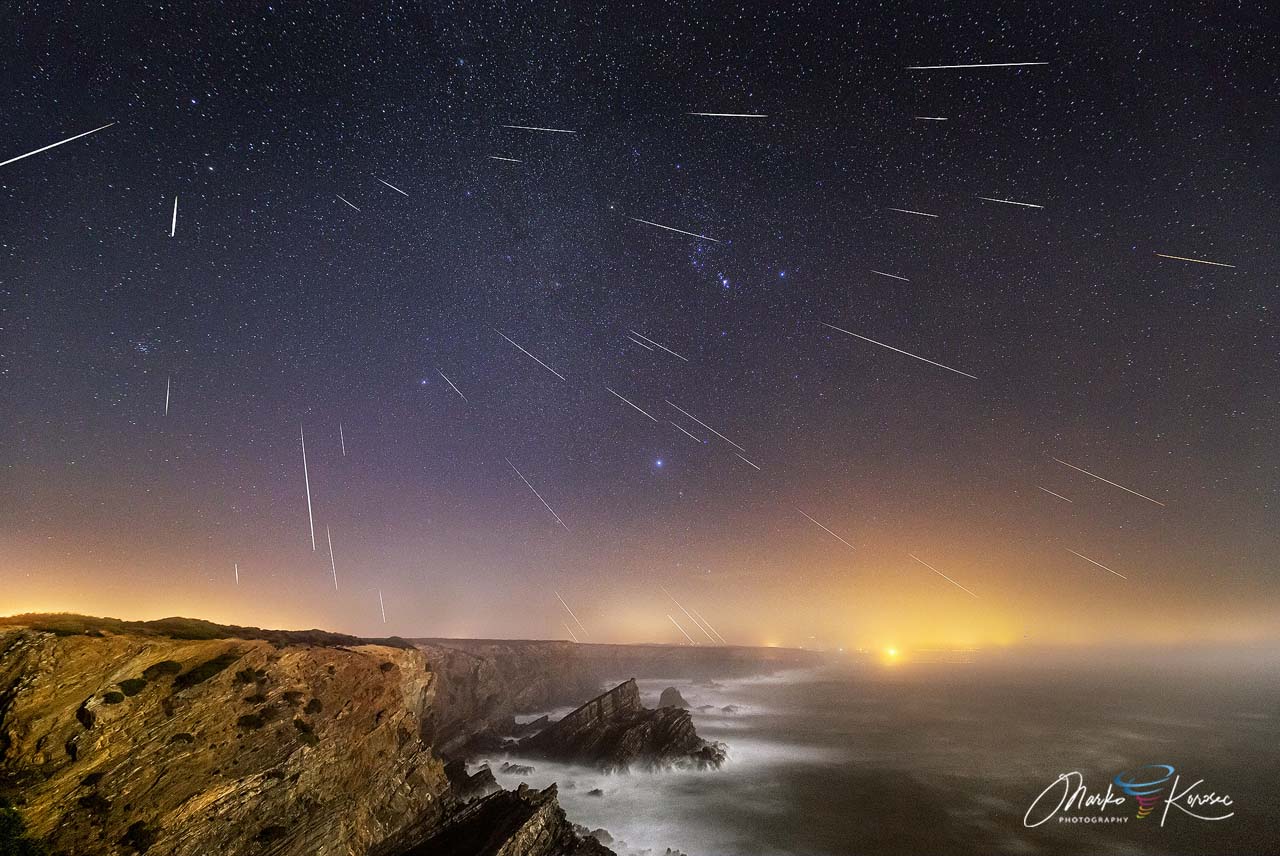
The Geminids are getting stronger every year, as the debris stream which is the source of them is thickening over time. And also, the peak occurs very close to the Earth’s perihelion, which means when our orbital speed is greatest, typically leading to faster meteors.
And similar to last year, the Geminid meteor shower 2021 peak coincides with no Moon, as it sets after your local midnight on Monday night. Thus creating near-perfect conditions around the world, the rest will depend on the cloudiness.

Keep in mind that although the peak normally happens on December 14th morning, Geminids activity will remain quite high also in the nights around as well, so from Dec 12/13th to Dec 15/16th.
WHAT IS THE FORECAST FOR GEMINIDS’ 2021 SHOWER?
Geminid meteor shower is the best known and most reliable of the two major annual meteor showers, the other are Perseids. In the mid-latitudes across the Northern Hemisphere, the Geminids radiant rises around local sunset, reaching the usable elevation for observations from the late evening hours until the dawn the next morning.
The Geminids 2021 are expected to produce 80-120 meteors per hour under clear and dark skies each night from this Sunday through Thursday next week, with potentially even more than 150 meteors per hour during the peak night hours starting early Tuesday morning, Dec 14th. It is surely advised to observe all nights around the peak date.
In the Southern Hemisphere, the Geminids radiant appears usable only around local midnight hours or so, as it culminates near 2 am local time. So a short window this year with the Moon setting around 1 am. However, although not having the most ideal conditions there, the Geminid shower produces a great show of often bright, medium-speed meteors.
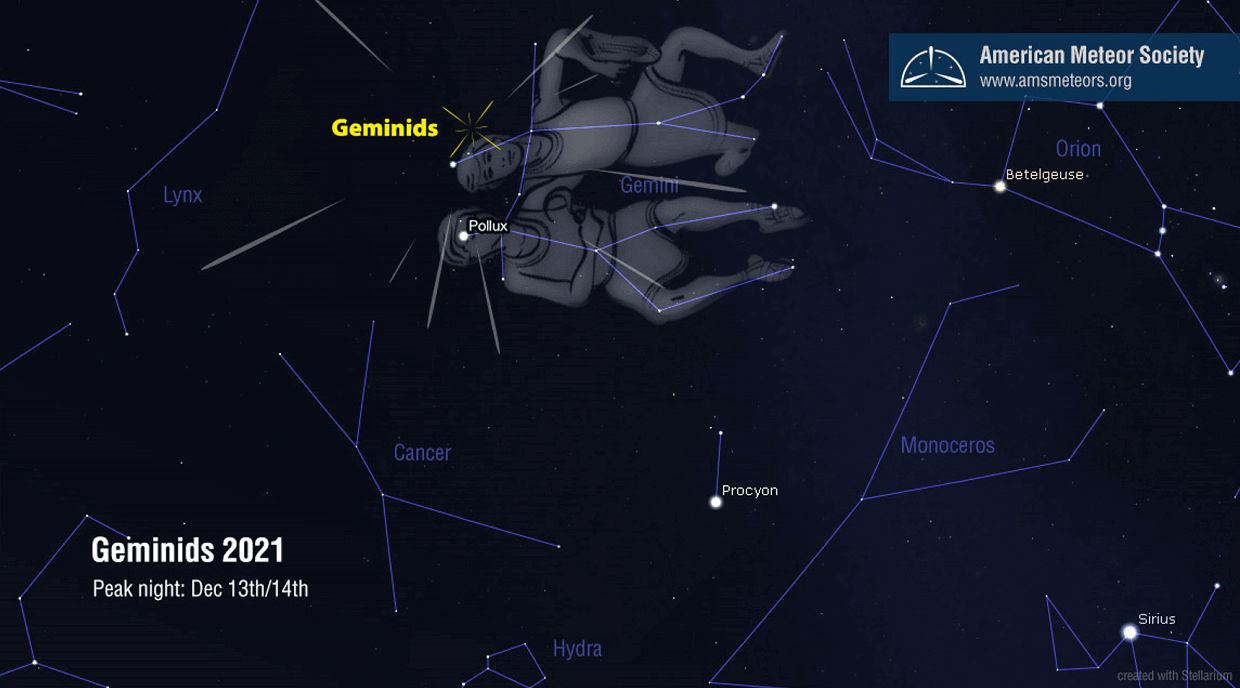
While the Geminids are by far the best annual meteor shower, they are also giving us difficulties for observations. The mid-December weather patterns across the Northern Hemisphere are often dynamic and unsettled conditions are found in many locations being under thick clouds or high moisture. So observing conditions in winter are much more difficult than during the summer meteors, e.g. Perseid meteor shower, but the skies are usually crispier due to colder temperatures and less haze.
Interestingly, observations of the peak rate of meteors (ZHR*) have shown there is a slight increase over a longer period and reached around 140–150 meteors per hour in recent years. And the near-peak Geminid meteor shower rates persist for several consecutive hours, so many parts of the world have the chance to enjoy at least part of the shower’s peak celestial show.
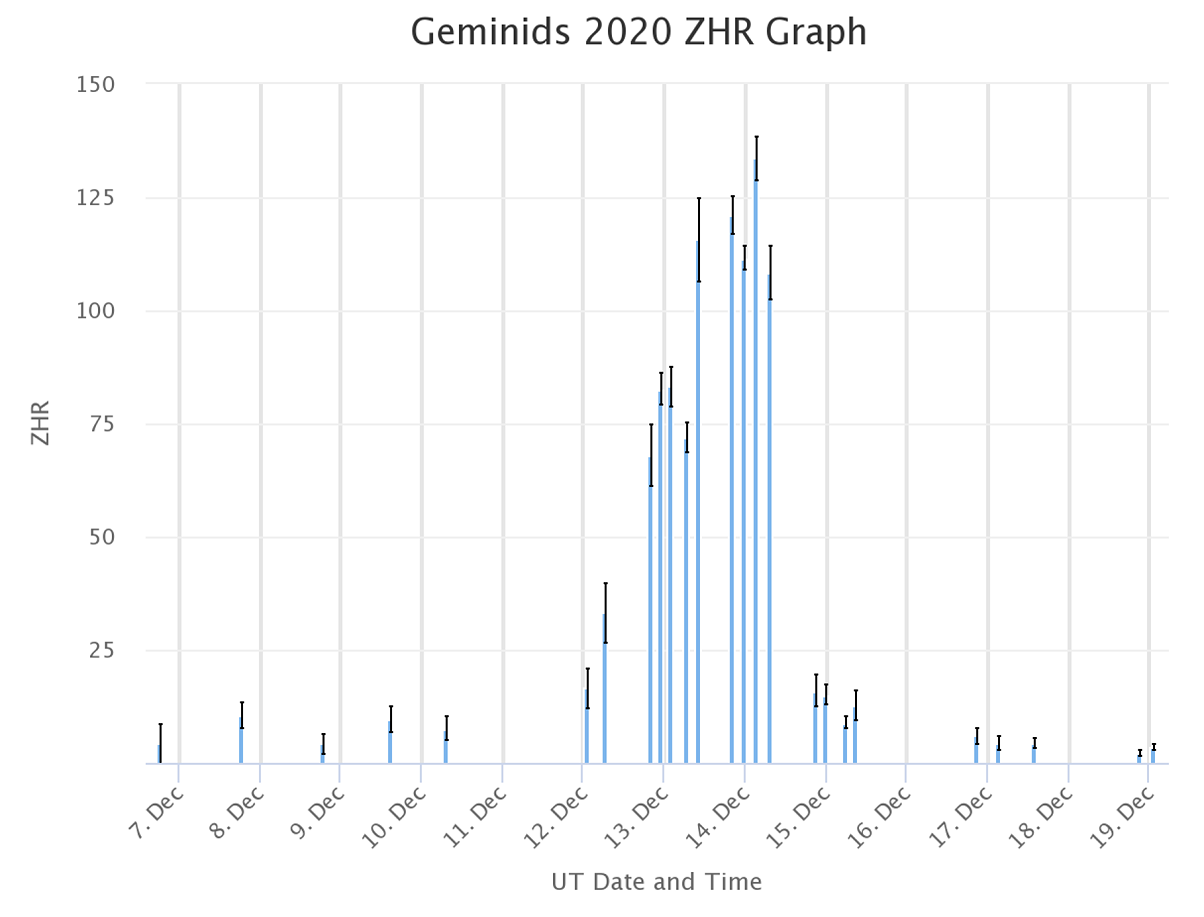
*ZHR – the Zenithal Hourly Rate of any meteor shower is the number of meteors a single person would see in one observing hour during peak activity if it was at the zenith (directly above our heads). This is indeed assumed that the present conditions are excellent (meaning that dark skies are present, with stars are visible up to magnitude 6.5). The hourly rate that can effectively be seen is almost always lower and decreases the closer the radiant is to the horizon.
And what is great with the Geminid meteor shower 2021 is that it again returns with a completely Moonless second half of the night, therefore the peak is optimally placed for a spectacular celestial show this year! Same as last year.
WHAT ABOUT THE TEMPERATURE FORECAST?
As we are now into the first month of winter season 2021/22, we can expect colder weather for sure. But will it be freezing cold or decent warmth at your location during the long nights from tonight through Thursday? Let’s see the high-resolution 2-meter temperature forecast for Europe and the United States below:
As we noted earlier, be sure not to wait until the peak night to watch and photograph the Geminids, as we expect all nights from Sunday night through Wednesday night to produce a great meteor shower display for many locations.
Long story short: The Moon setting soon after midnight and the Earth are in just a great position for yet another spectacular celestial show this year. If the clouds will cooperate with us during the peak on Monday and Tuesday nights, Dec 13th and the 14th, treat yourself to the greatest natural show of 2021 (or recent years)!
A HISTORY OF GEMINIDS – AN UNUSUAL METEOR SHOWER
The Geminids are, in addition, to be known as the strongest and the most reliable annual meteor showers, also one of the weirdest meteor showers we know. While the majority of meteor showers we observe originate from comets, icy dirtballs on elongated orbits around the Sun, the Geminid meteor shower originates from an asteroid. The parent body from which all the pieces that burn up in our atmosphere as the Geminids, is asteroid (3200) Phaethon.
Phaethon is a relatively small space rock that is only about 5.8 km in diameter. The asteroid orbits the Sun in a very elongated elliptical orbit that takes it into the inner parts of the Asteroid belt as its farthest from the Sun, to well within the orbit of Mercury as it is the closest to the Sun.

Phaethon is also designated as a potentially hazardous asteroid for us, as it can come as close as 2.9 million km to the Earth (7.6 Earth-Moon distances). However, it currently poses no impact threat for Earth. And the Geminid meteors are actually getting stronger every year and a half (approximately 18 months on average), as that is the time required for Phaethon to complete an orbit around the Sun.
Meteoroids are dust particles that produce meteors and with most meteor showers they come from comets. They are released out from the comet’s nucleus by outgassing as the comet rounds the Sun and warms up. While an asteroid does not contain volatile ices that could produce outgassing as it rounds the Sun.
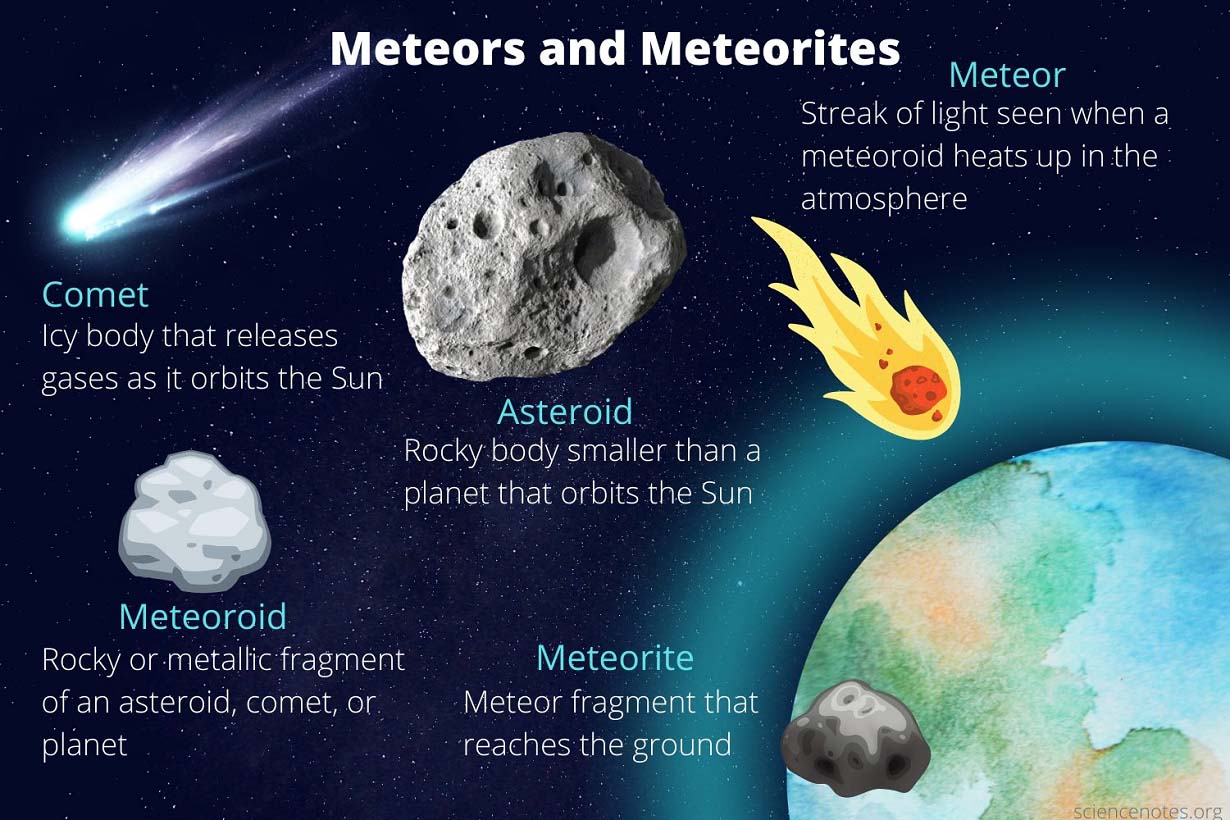
So, the mechanism by which Geminid meteoroids are released from the Phaethon asteroid is still quite a mystery. However, the observations have shown it to occasionally brighten and develop slight cometary features when it is close to the Sun. That is why some researchers are calling it a ‘rock comet’, proposing that bits and pieces are breaking off the asteroid-like with the typical comet.
The surface of the asteroid can also heat up 700 °C as it rounds the Sun with a distance more than twice as close as the scorching hot Mercury, producing thermal stress on the rock on the asteroid’s surface as well as a breakdown of clay minerals, being blown from the asteroid’s surface by the Sun’s radiation pressure.
Then, other researchers argue that the amount of Geminid meteoroids are so great that it could only have come from the breakup of a larger parent asteroid, with the largest remnant being the 5.6 km Phaethon asteroid.
Geminids – a young meteor shower
The first time Geminids were noticed in literature was in the 1830s, there are no reports of sightings of this meteor shower prior to that. Therefore it is highly unlikely that the Geminid meteors would have been missed as other annual meteor showers, such as the Lyrids, the Perseids, and the Leonids had been observed for centuries.
Since the first reports less than two hundred years ago the Geminid meteor shower has been increasing in strength and is now the strongest annual meteor shower, by quite a significant margin compared to other meteor showers. The summer Perseids are the second shower after Geminids.
HOW CAN WE SPOT THE GEMINIDS IN THE SKY?
Let’s see another area in which the Geminids excel. Unlike most other annual meteor showers, the Geminids can be seen well already in the evening hours. In fact, Geminids can be seen throughout the whole night! Because the visibility of the meteor shower and the number of meteors is closely tied to the position of the constellation of Gemini in the night sky.
All Geminid meteors will look like they come from a point in the sky in the constellation Gemini (The Twins): even on the other side of the sky, if you trace a Geminid’s track backward it will point to Gemini. This point in the sky is called the radiant. The higher the radiant is in the sky, the more meteors we can observe.
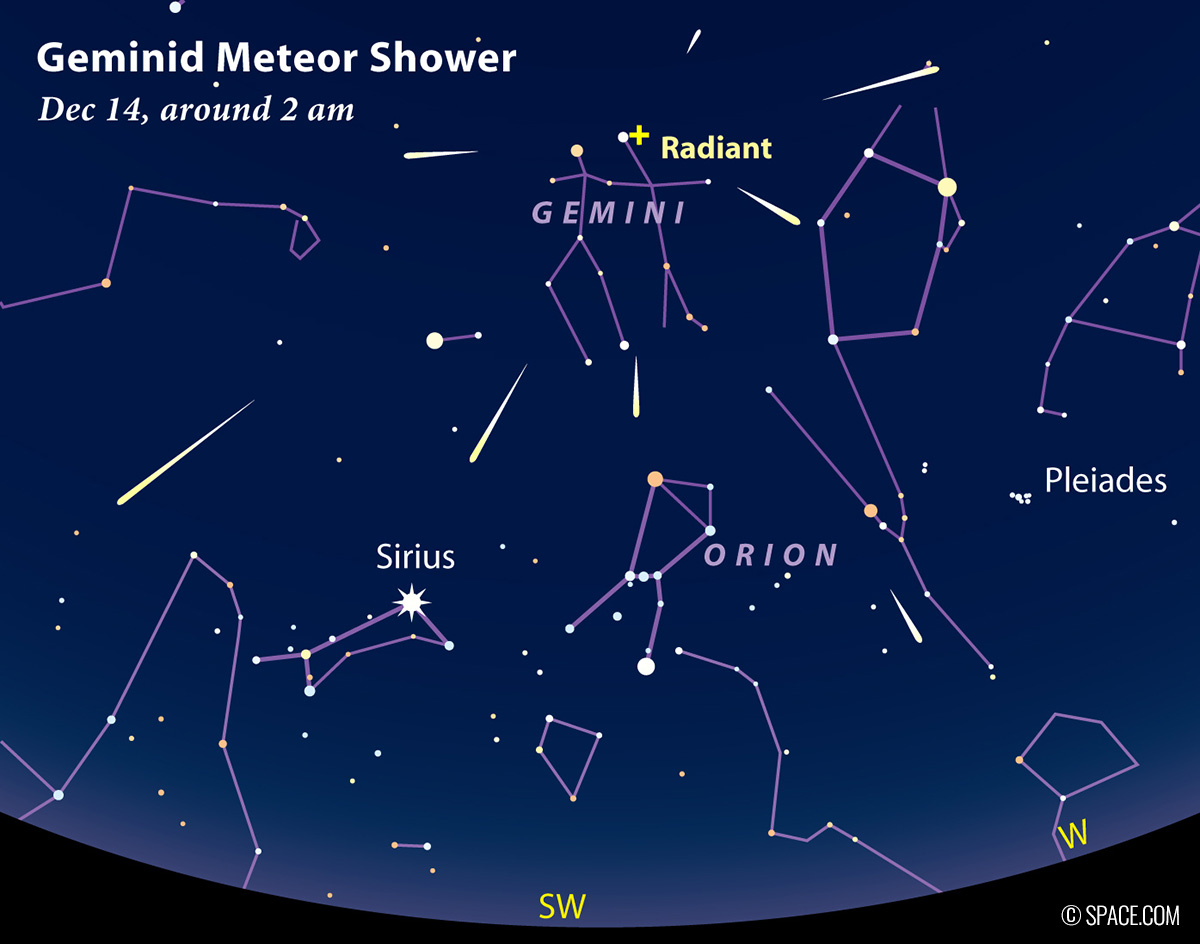
In the early evening hours, the Geminids radiant is low in the eastern sky, rising higher in the sky during the evening and late-night hours. It is the highest around midnight and into early morning hours when the activity of the Geminid meteor shower will be highest. The activity diminishes towards the dawn as the radiant descends into the western sky, but there will be plenty of Geminids in the sky just before dawn as well.
As it happens with every meteor shower or night sky observation, one of the most important factors is the weather conditions. No matter how intense the meteor showers can be, how ideal conditions completely moonless nights and crispy skies can bring, if there are cloud is the sky, you’re out of any chances to see meteors or the sky itself. Unfortunately.
Let’s now see how the weather forecast will permit or limit the observations across Europe and the United States during the peak time from Monday through Wednesday this coming week.
GEMINID METEOR SHOWER CLOUD FORECAST ACROSS EUROPE
The Geminid meteor shower 2021 over Europe will happen after quite a dynamic weather pattern. There will be a developing higher pressure and stable conditions over the large part of the continent, with a large upper low situated over the southern Balkan peninsula and the upper-level trough over the far North Atlantic.
In between these lows, the upper-level ridging will build up from southwestern Europe, extending across most of western and central Europe, also into the Baltic region and Scandinavia.

These patterns will allow relatively stable conditions in the broad zone extending from the Iberian peninsula across the Alps into Scandinavia, the Baltic region, and eastern Russia, but stable weather is not all we want to know. Cloudiness depends on the inversion layers which are an important role during the winter months.
Monday night, Dec 13/14th
If we now take a look over the total cloud cover forecast across Europe during the peak night (Monday night) below, we can see the cloudiness is likely to be spread across a large part of Europe. Very poor to non-existing chances are seen over western, northern, and eastern, thanks to the strong thermal inversions and cloud deck in the low to mid-levels.
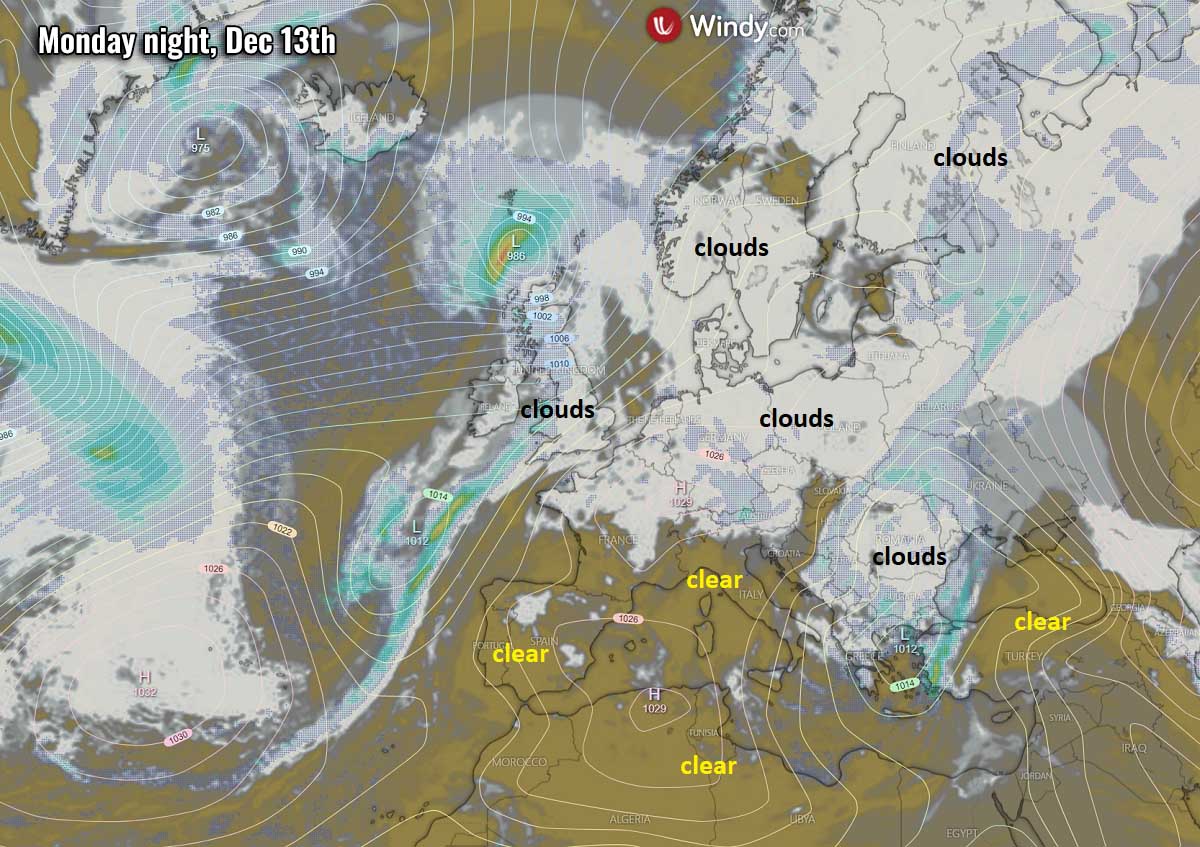
However, there are quite good conditions with almost no clouds in some areas. Especially a large part of the Iberian peninsula and the western Mediterranean, including part of Italy and southern France, can expect clear skies or at least good conditions for skywatchers. Some chances for clear skies are also possible over central Sweden, southern Mediterranean, and east-central Turkey with Georgia. North Africa seems to receive great conditions as well for Geminids this year.
Tuesday night, Dec 14/15th
As the peak for Europe occurs during the late morning hours on Tuesday, let’s see how the conditions will be for Tuesday night. A developing large North Atlantic depression will maintain clouds into western Europe, as well as over Scandinavia despite some breaks in the clouds possible over England and Norway or Sweden. It will remain cloudy over most of western and eastern Europe and the Baltics. As well as most of the Balkan peninsula.
Observing conditions will remain good over the Mediterranean and south of the Alps. Also northern Africa. It seems that Tuesday night will favor good chances over southern France, Spain, Portugal, Italy… but possibly also across Slovakia and Hungary. Especially higher elevations of low cloudiness will pack the lowlands.
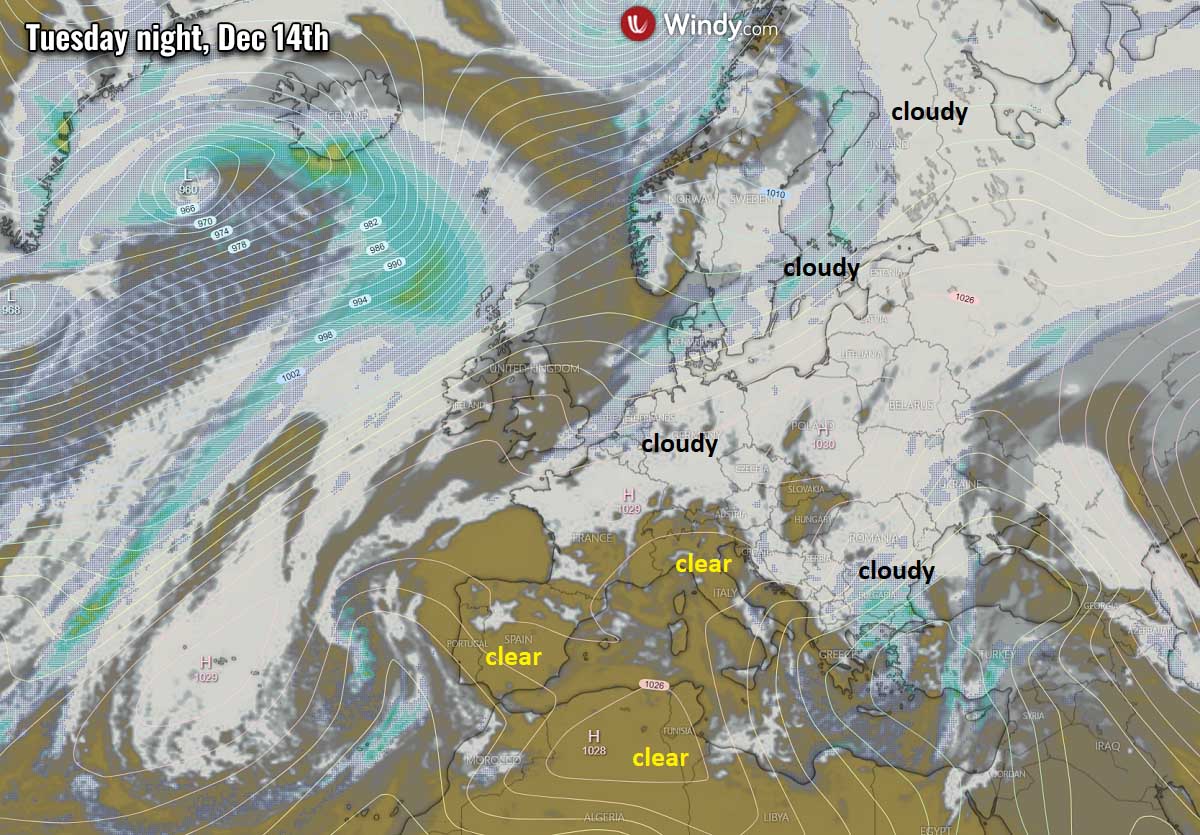
As we can see, both days will bring the southern parts of Europe into some good conditions. This should introduce great night conditions for skywatches and hopefully some fine Geminid meteors.
GEMINID METEOR SHOWER CLOUD FORECAST ACROSS THE UNITED STATES
Now let’s take a look at what’s on the weather models for the United States skywatchers. After a major frontal system with a deadly tornado outbreak from the mid- Mississippi Valley into the Ohio Valley, a developing strong blocking pattern takes place. An upper-level ridge strengthens across the eastern and central parts of the country with a deep trough emerging into the West Coast.
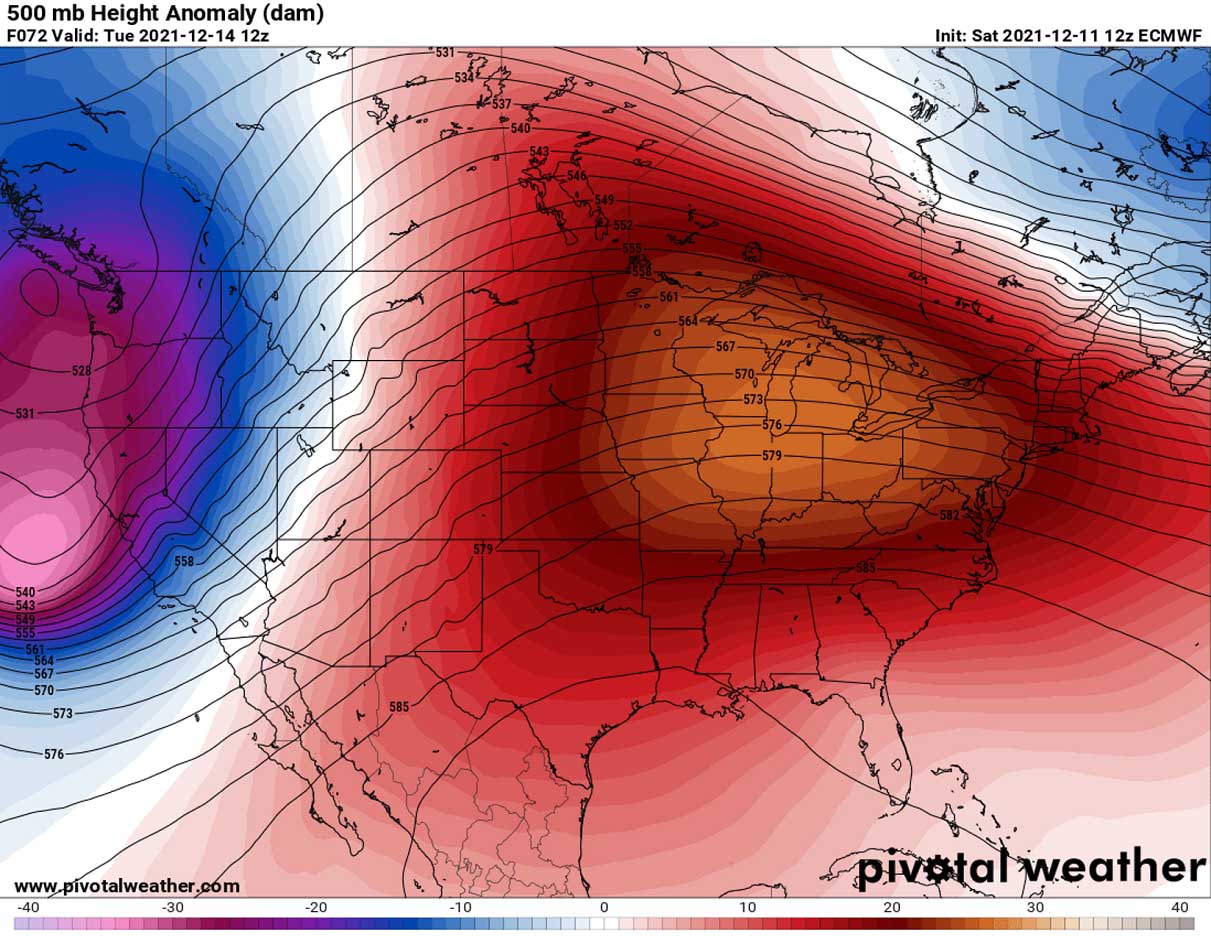
Under the blocking High, stable weather will spread east of the Rockies at least, so conditions will be quite favorable and chances are quite good around the Geminid meteor shower peak this year.
Monday night, Dec 13/14th
Here is the cloud cover across the Contiguous United States on the peak night, Monday night. As mentioned earlier, the deep trough sitting along the Pacific Northwest will support strong cloudiness and precipitation on the west, therefore chances are rather poor in these areas.
But conditions will be improving across the Rockies to the east, extending from West Texas to Dakotas but with some potential for low clouds or fog across the Great Plains. These areas across the High Plains should have some very nice skies, especially as also very dark skies are over there with very low light pollution. Moisture will develop clouds closer to the Gulf of Mexico.
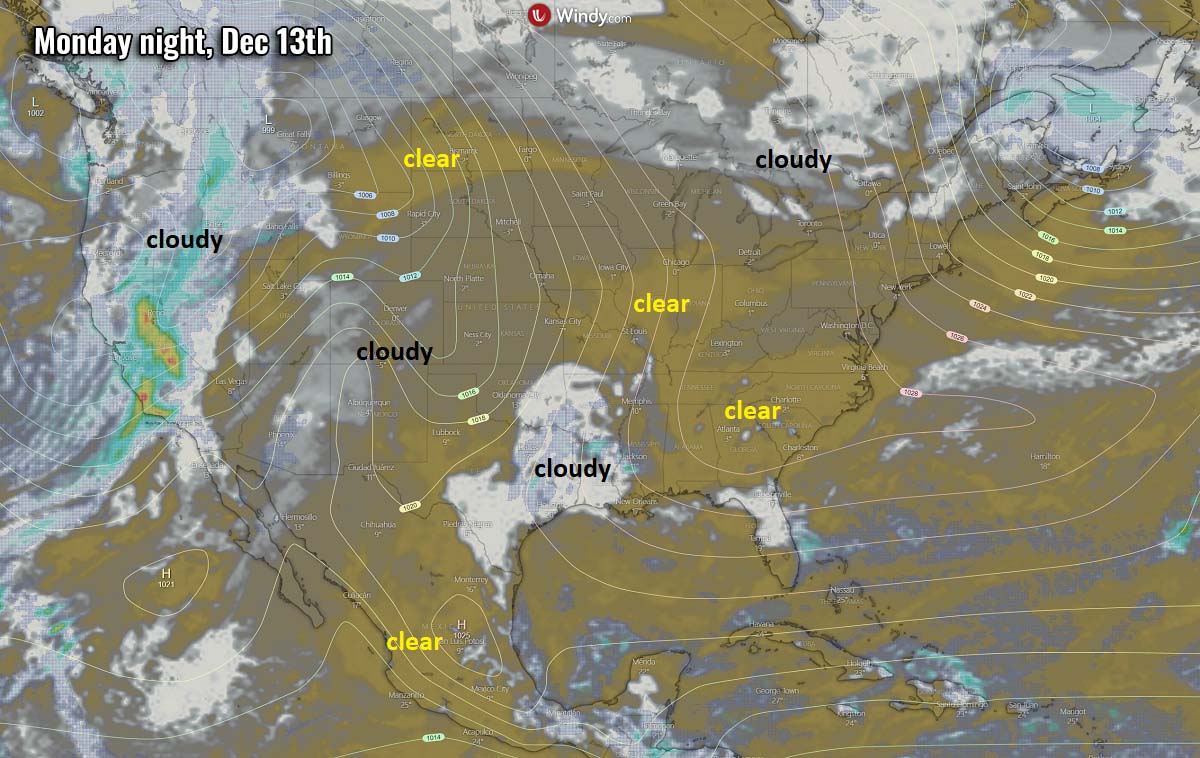
There will also be some changes across the Southeast United States, as well as across the Midwest, the Ohio Valley, and Carolinas, and the Mid-Atlantic States. Not perfectly clear, but at least some chances are there. Clear skies also in central Mexico.
Tuesday night, Dec 14/15th
The next night on Tuesday will also give some good chances again. Clearing skies are likely across eastern Wyoming into Dakotas, possibly across the Great Plains to Mexico, the Southeast US, and Florida, as well as the New England on Tuesday night.
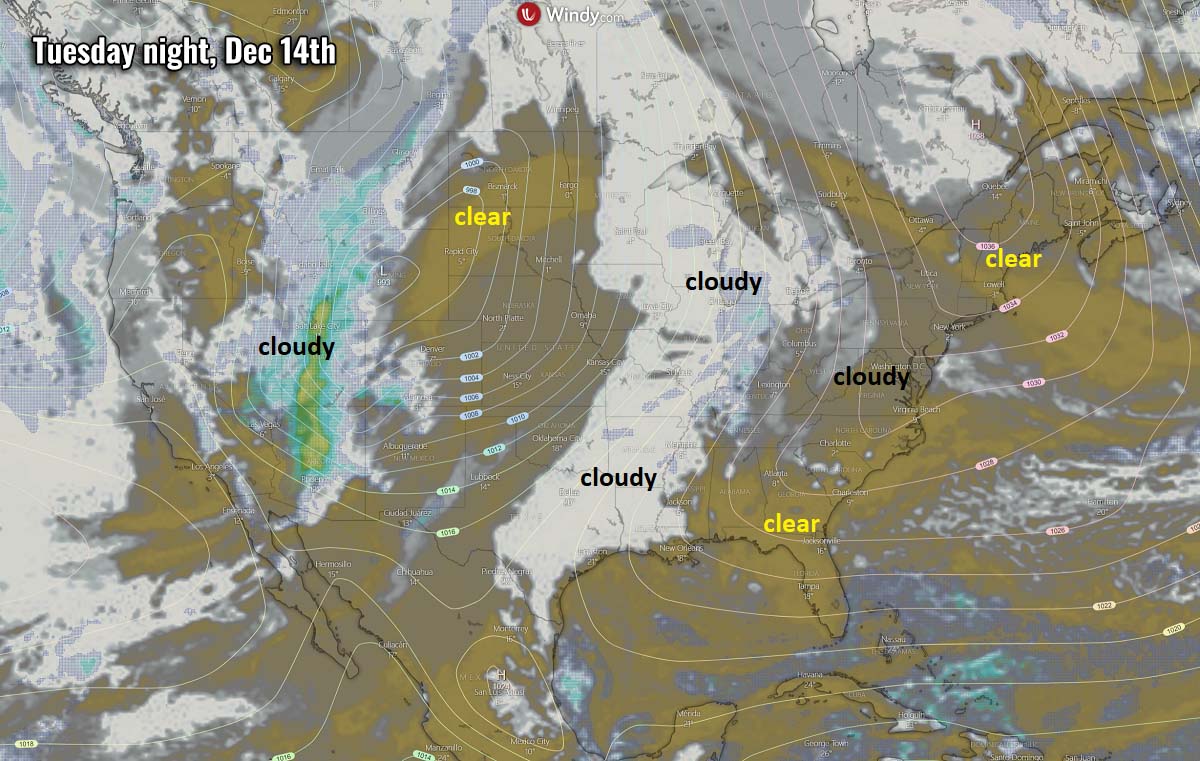
Unfortunately, another potentially strong frontal system emerging across the Rockies will bring clouds in between, from the Gulf of Mexico across the Mississippi Valley and Midwest to Great Lakes. This will strongly limit the good chances for Geminids after the peak night.
So, as we can see, at least the central parts of the United States and the High Plains, including the Southeast and Northeast US will enjoy good conditions this year. With the Moon setting soon after midnight, and a high hourly rate of Geminids forecasted, skywatches can expect a quite spectacular celestial show!
METEOR PHOTOGRAPHY – HOW TO PHOTOGRAPH A GEMINIDS
After enjoying observing the meteors, many of us are also interested in photographing the meteors. Meteor photography is a lot of fun and with a bit of luck, we can catch a big and bright meteor! Here is how you do it too.
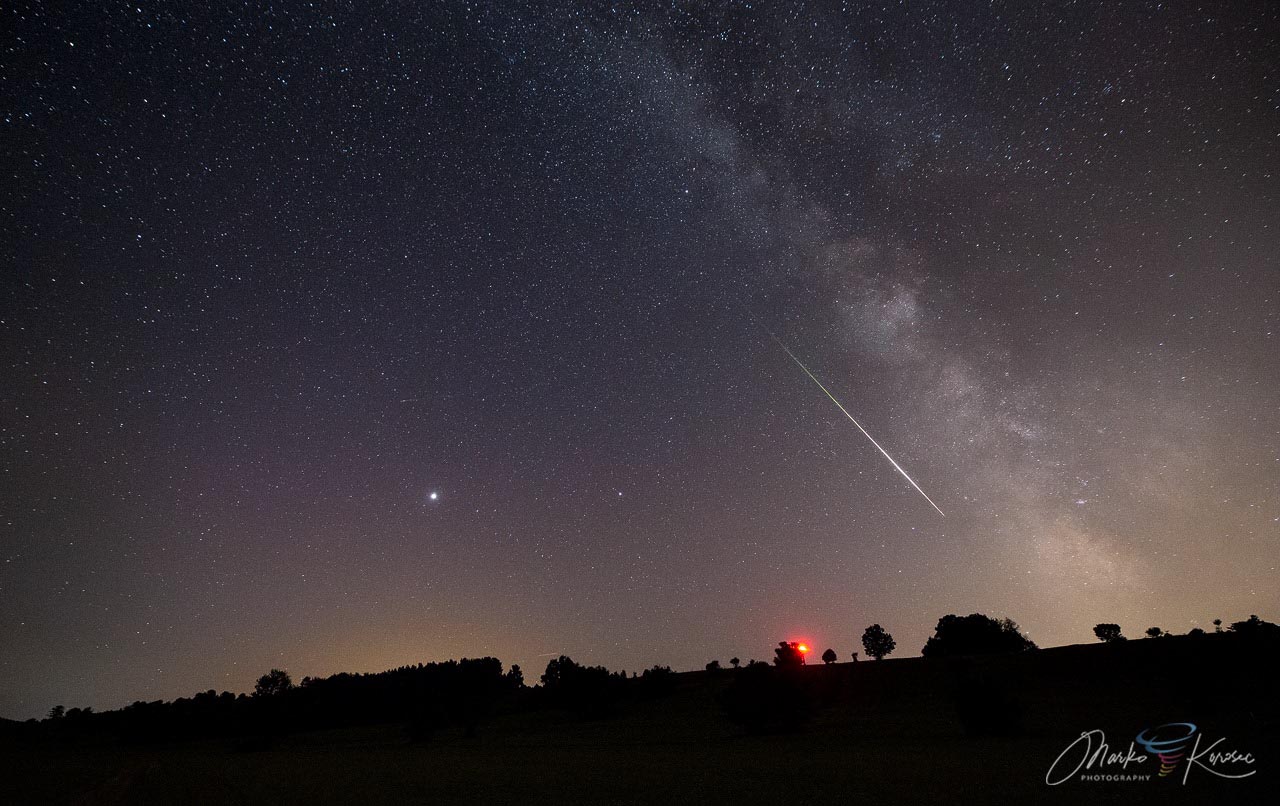
PHOTO EQUIPMENT
- A digital camera that has the option of making long exposures. Any interchangeable lens camera (DSLR or the newer mirrorless cameras) will have the option, many compact cameras and some phone cameras also have the option now.
- A remote (wired, wifi or bluetooth) trigger for the camera (or trigger timer).
- A strong and sturdy tripod.
- And indeed a meteor shower. The stronger it is, the better results will arrive.
HOW TO PHOTOGRAPH – CAMERA SETTINGS
The best period to photograph meteors is sure during a maximum of major annual meteor showers, such as the Quadrantids, Perseids, and Geminids. Moderately strong meteor showers, such as the Lyrids, Southern Delta Aquarids, Orionids, Northern and Southern Taurids, Leonids, and Ursids are very good ones too.
When we photograph meteors, let’s avoid using Auto and preset scene modes. You want to be in control of the camera and set the photography mode to take long exposures. There are several ways about it and they may vary depending on your camera brand. The most used is the M – Manual mode. Some of the cameras may also have B – Bulb mode. This mode allows you to use a remote trigger to do exposures of any length, while the M mode normally limits the exposure times to 30 seconds.

The other mode that is useful is also the shutter priority mode (Tv or S in some cameras). With the Av mode, we can select the exposure time for the photo. All interchangeable lens cameras have these modes, regardless of the brand – Canon, Nikon, Pentax, Sony, or any other, you will be fine.
HOW TO PHOTOGRAPH – CHOOSING LENS
Virtually any wide-field or standard lens will get this job done, so will any mid-range zooms. Most entry and up to prosumer crop sensor (DX or APS-C) cameras come with a mid-range ‘kit’ zoom lens, which is usually between 16 and 18 mm at the wide end and f/2.8 to f/4. The standard 50 mm lenses are fine too, usually with wide-open F stop as f/1.4 to f/1.8. They gather a lot of light into the sensor, so they can capture fainter meteors than mid-range zooms as well.
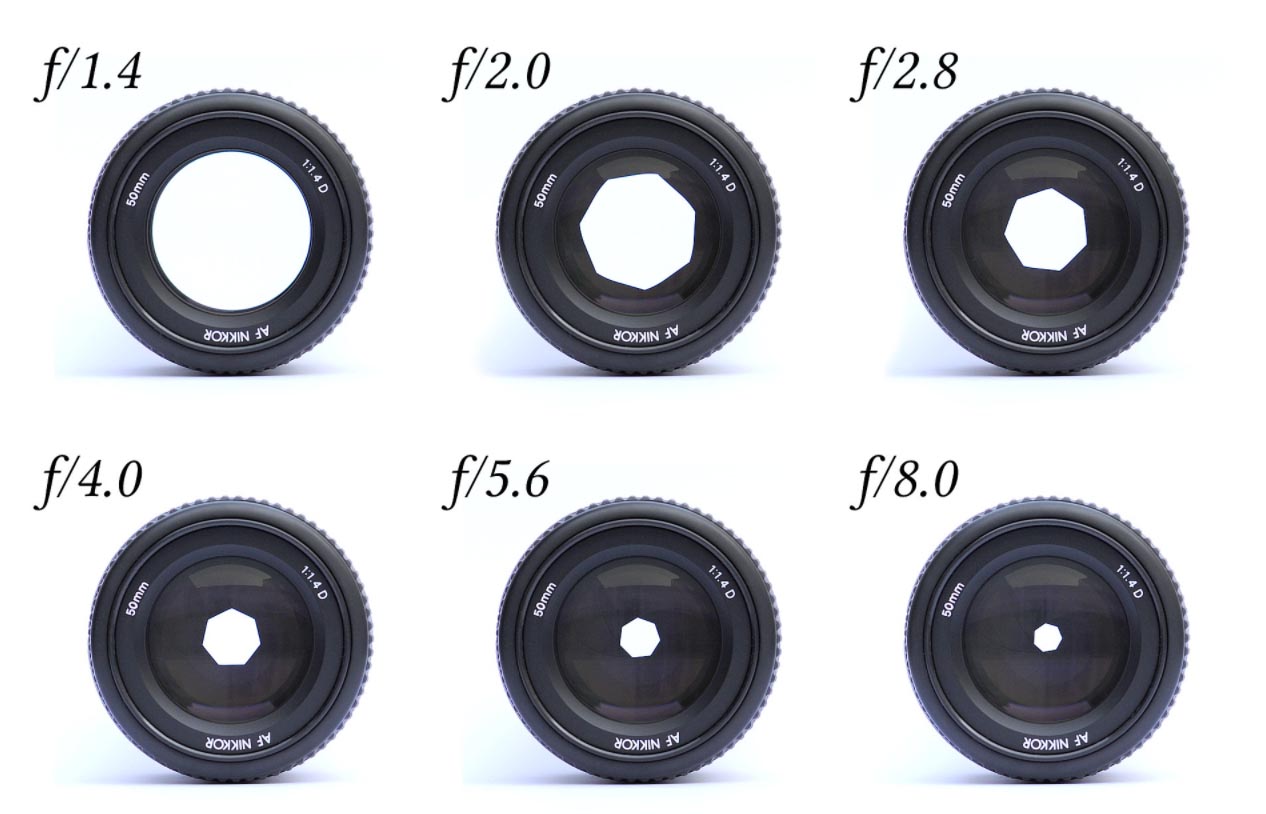
The downside of these standard lenses is the small field of view, particularly on crop sensor cameras. 50 mm will be OK, but do not go to longer focal lengths as the field of view becomes too small. It is preferred to use wide lenses of 24 mm or wider you can get.
The above are all fine for good meteor photography. Then, just use a sufficiently high ISO setting to capture meteors, 1600 or more will be good enough for a start. How high ISO you want to go depends mostly on your tolerance for noise. But nowadays, many cameras are able to give great results with even 3200 ISO or higher.

To conclude, the best lenses for meteors photography are the newest wide-field lenses with maximum aperture f/1.4 to f/2.0, available from several brands (Samyang, Rokinon, and, especially, new Sigma Art).
In the field, after you select the mode and prepare the camera (mounted on the sturdy tripod), make sure the camera is at a good level. Look through the viewfinder and make sure that the horizon is level, then focus on the lens. The easiest way to set the proper focus on the lens is to set it to manual and focus it on a distant light or a bright star. Use live view (with maximum magnification) to make it even easier.

Once you have done with the focus, keep the lens in manual mode to avoid the camera refocusing. Set the aperture to fully open (widest possible) and the high ISO. You are ready to go and try your luck. Be prepared to take *many* photos before catching the first good meteor. The more persistent you are, the more likely you will catch a great one!
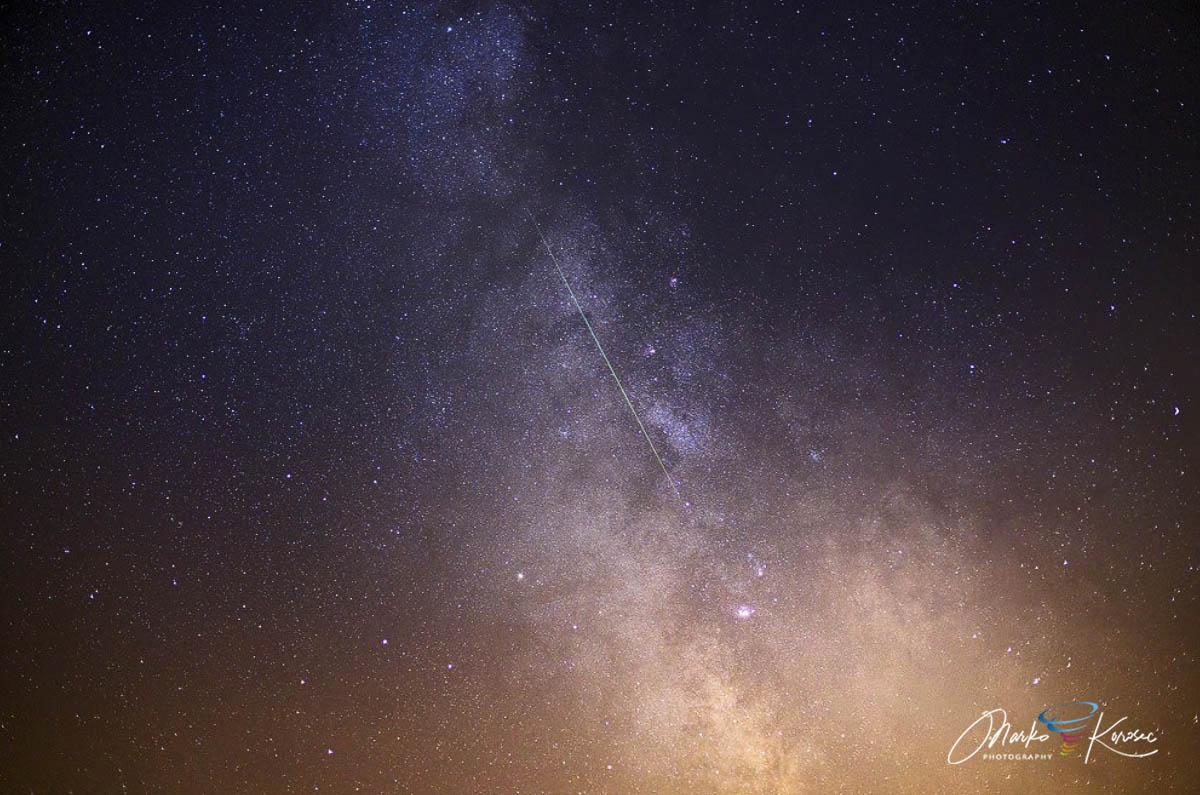
The photograph above represents how a typical meteor will look like. A streak of light, likely greenish. Unlike the weather or communication satellites in the sky, a meteor will have a relatively smooth light curve – brightening steadily, brightest in the second half of its trail, and a more steep brightness drop-off at the end of it.
The brightest meteors can be punctuated by irregular brightness flares.
EXTRA PHOTOGRAPHY TIPS FOR NIGHT SKY
- Avoid getting the background too bright, as you want a good contrast between the sky and meteors. Typically a histogram with a peak around 1/8 to 1/6 full (left to right) is considered optimal. This will depend on the lens you use, your ISO setting, and how dark the sky you have found. Fast lenses and high ISO settings will get your background bright faster, take this into consideration. A bright, light-polluted sky will also get the background bright even faster. An f/2.8 lens at ISO 3200 under a good rural sky will take about 20-30 seconds of exposure.
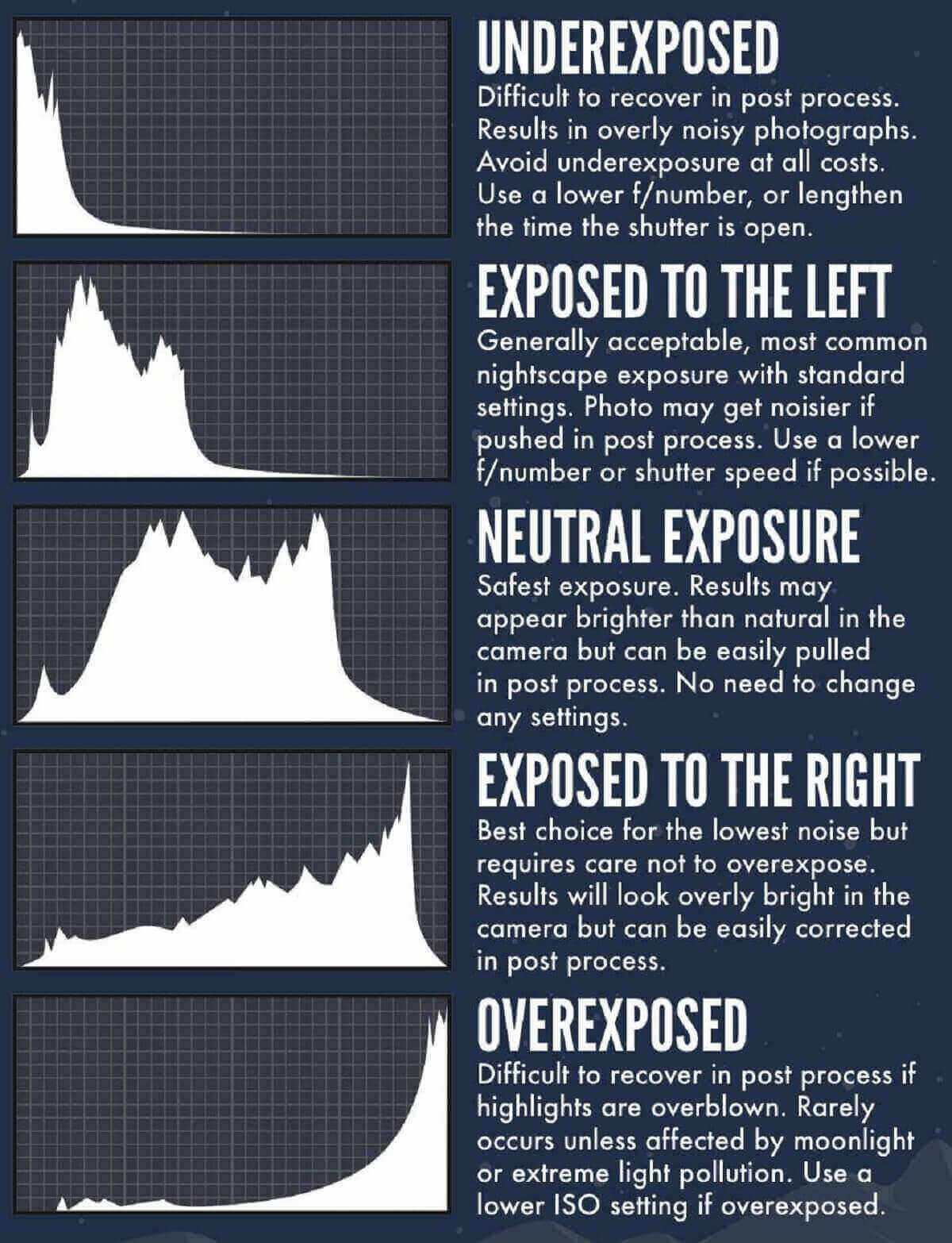
- Very fast lenses, f/1.2 to f/1.8 will produce the best results under very dark skies. Brighter, light-polluted skies will saturate the background quickly so it is always advised to search for the darkest spots possible.
- Do not use too short exposures with meteor photography. The shorter exposure you set, the more likely you are to get a ruined photo by ending the exposure in the middle of a bright meteor. Imagine how extremely frustrating this could be. With only a 10-second exposure, you would ruin 5-10% of meteors.
- Keep your horizon (ground with some landscape) in the photo. Most bright meteors appear close to the horizon as you are looking through a larger volume of the atmosphere close to the horizon than if shooting overhead. If you decide to use a 50 mm or another longer focal length lens, keep your field close to the radiant. Otherwise, meteor trails will be too long to fit into your field of view.
- Remember to turn off your High ISO noise reduction in the camera. You can do a proper and better noise reduction in post-processing.
- Also turn off your Long exposure noise reduction. In this setting, the camera makes a dark exposure for every photo you make. In other words, this means that you will only photograph the sky 50 % of the time, missing half the meteors. It is pretty frustrating missing a superb meteor while your camera is making a dark exposure in that time, oops.

- Always take photographs in RAW format, or RAW + JPEG. It pays off a lot to have a RAW photo to process and edit later.
- Keep your white balance on AUTO, as it typically still works best. You may want to change to a warmer setting (some astrophotographers prefer 3700 Kelvins) under light-polluted skies, when we have variable cloud cover and the clouds are illuminated by light pollution or if your camera is having trouble keeping the white balance constant. Shooting in RAW allows you to easily correct white balance in post-processing later.
- Preferably use Live View and a bright star or very distant lights to focus your photo. Make absolutely sure your focus is dead on before your start. This is another frustrating thing making out-of-focus photos of bright meteors. Keep your camera and lens in manual focus mode all the time, as otherwise, the camera will try to refocus once you start your exposures and your photos will be out of focus immediately.
- Normally, you would avoid areas with moist air: find a hilltop or ridge, avoid depressions and valleys. Once your lens dews up it is next to impossible to keep photographing for long. If this happens, we can leave a spare lens in the car and use it as a replacement once your first lens dews up. Get the other lens into the car to warm it up, and repeat this throughout the night. Alternatively, you can also use lens warmer bands that are available by a number of suppliers: they run on batteries and keep the lens just warm enough not to dew up during photographing in cold ad moist weather.
- Bring backup batteries, a lot of them. And spare memory cards, less is more is not an option when photographing a meteor shower.
- Cameras and our eyes don’t see meteors the same. A good bright meteor, as bright as the brightest stars, will register on your photo as a faint streak of light. You will need a really bright meteor to produce a beautiful photo. Only if you use very fast lenses and very high ISO settings will allow you even moderately bright meteors look significant at the end. But do not be discouraged, with a little luck and perseverance you *will* get a fine photo and a bright meteor, possibly even a fireball!
WHAT TO EXPECT WITH METEOR PHOTOGRAPHY?
Honestly? Surely be ready to take hundreds of photos during the whole night! At first, be prepared to spend at least an hour or two under the stars to catch a good one, even in the strongest of meteor showers, like the Perseids or the Geminids. Those moderate meteor showers as the Lyrids or the Orionids take even more time as their ZHR is lower. But the more time you spend photographing a meteor shower, the better the chances are you will catch a good and bright meteor.
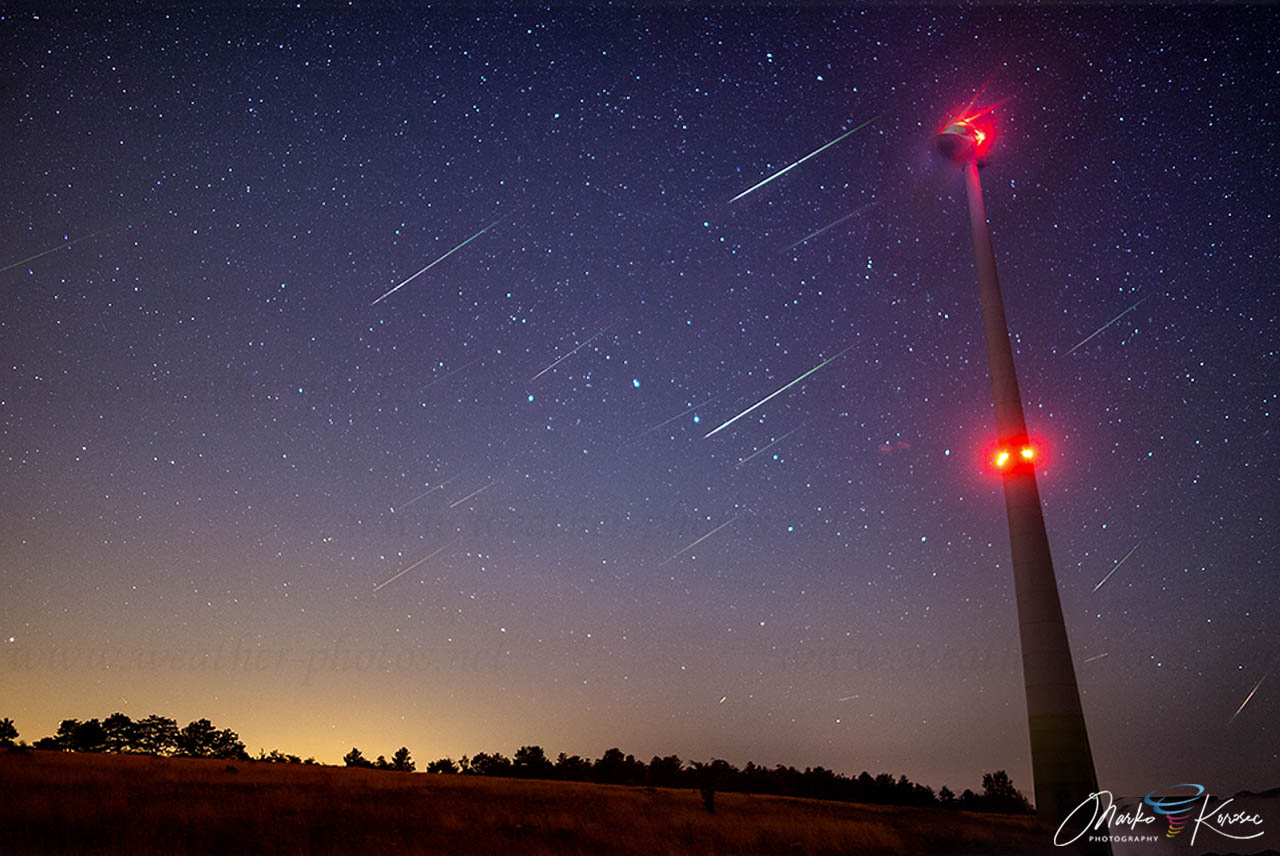
Meteor photography can often bring hours and hours of shooting the night sky. But, when things go right… whoa, you will be rewarded! Imagine you catch an exploding fireball? It happens, trust us!

CONCLUSION – GEMINIDS 2021: A SPECTACULAR DISPLAY LIKELY
Now, what can we say for the end… certainly you don’t want to miss this one out, Seriously!
Although we have quite difficult weather patterns during the winter months and what appears likely also quite challenging weather conditions in 2021, take this one very seriously as last year.
Geminids’ celestial event this year is expected to produce around 80-120 meteors per hour during each night from Monday through Thursday this week. The peak occurs from Monday evening until dawn Tuesday, Dec 13/14th, with very likely the Zenithal Hourly Rate (ZHR) of more than 150 meteors per hour!
And what is also one of the greatest facts with the 2021 Geminid meteor shower is that they again bring the peak hours without the shining Moon, so moonless pre-dawn hours are expected. Therefore, the Geminid meteor shower peak will happen with basically ideal conditions (depending on the weather at your location, obviously) and we are up to a great celestial show this year too.
*ENJOY* your peak nights observing the spectacular Geminids celestial display and feel free to report your observations to our Facebook Report and Discuss group – we will be happy to share those with our followers for you!
Like the astronomers and astrophotographers would say – CLEAR SKIES!
See also: